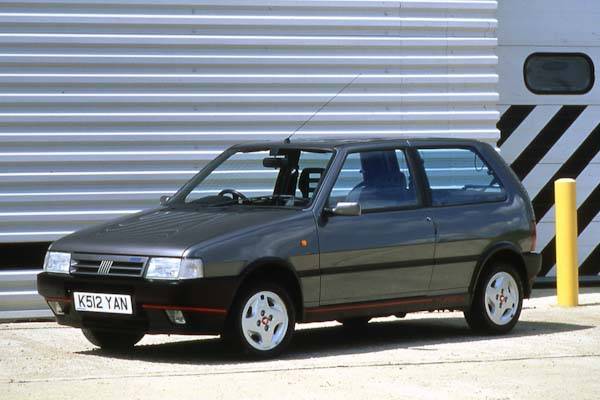
RAC Breakdown Cover from £7 a month*
*£7 a month for new, single vehicle Basic cover. Comparison based on www.theAA.com closest equivalent cover as at 12/04/24.

BY JONATHAN CROUCH
Introduction
The Fiat Uno may not have rewritten the rules that underline the supermini concept, but you have to say that it achieved just about everything else. By the time the car went out of production in 1994, over five million had been sold and it was often the best selling car in Europe.
Which means of course that there are plenty about on the used market. However, quality is patchy and you'll need to buy with great care.
Models
Models Covered: First generation Uno - 1983-1990: (3dr hatch 'Uno 45' 0.9-litre [Formula] / 3dr & 5dr hatch 'Uno 45' 1.0-litre [FIRE 45, FIRE 45S] / 3dr & 5dr hatch 'Uno 60' 1.1-litre [60, 60S, Selecta] / 3dr & 5dr hatch 'Uno 70' 1.3-litre [SX, Turbo] / 3dr & 5dr hatch 'Uno Diesel' 1.7-litre [DS] ). Second generation Uno - 1990-1994: (3dr hatch 'Uno 45' 0.9-litre [Formula] / 3dr & 5dr hatch 'Uno 45' 1.0-litre [Start, FIRE, FIRE S] / 3dr & 5dr hatch 'Uno 60' 1.1-litre [FIRE S, Selecta] / 3dr & 5dr hatch 'Uno 70' 1.4-litre [S, Selecta, SX, Turbo] / 3dr & 5dr hatch 'Uno Diesel' 1.7-litre [Start D, D, DS]
History
The Uno was launched in 1983 to a warm reception. The first generation car, on sale until 1990, was a saviour for Fiat, selling in huge numbers. Several engines were available; 0.9, 1.0, 1.1 and two 1.3-litre units - including a turbo - plus a 1.7-litre normally aspirated diesel. Three and five-door bodystyles were offered and from 1988, there was a clever CVT automatic Selecta version.
To be honest however, most of these will be pretty tatty by now. Better by far to stretch to one of the post-1990 Second generation cars. Here, the 'Uno 45' 0.9 and 1.0-litre engines remained; the Uno 60's 1.1-litre unit - now dubbed 'FIRE S' - had been much improved however, and the 1.3 was replaced by a fuel injected 1.4 in the Uno 70.
The old 1.1-litre engine continued on for two years - but only in the automatic Uno 60 Selecta version. The 1.7-litre diesel too, was largely unchanged.
For Uno 45 buyers, the 0.9-litre cars came only in Formula form, while 1.1-litre buyers could choose between Start and FIRE guises. Diesel buyers had D or DS. Finally, 1.4-litre Uno 70 customers chose from fuel injected SX or Turbo models.
More affordable fuel injection arrived for Uno 70 buyers in June 1991 with the introduction of an entry-level S model. The smaller 1.0 and 1.1-litre engines received injection in September 1992, though normally aspirated 0.9-litre Formula and 1.0-litre Start models continued. A Start diesel variant was added in early 1994. Later that year, the range was finally replaced by the Punto.
What You Get
A capable supermini with good packaging. It's cheap to buy and maintain but not as satisfying to drive as, say, a Peugeot 205.
What You Pay
Please fill in the form here for an exact up-to-date information.
What to Look For
In two words, electrical headaches. Like many Italian cars, the Uno has a poor reputation on this front. A rather 'tinny' feel, tatty trim and patchy build-quality also afflict it. Don't be surprised to find much evidence of rust on poorly looked after older cars. A service history is worth its weight in gold. Even if you have this, you'd be wise to steer clear of the petrol turbos, most of which will have been thrashed to near-death. The diesel is worth avoiding too, it's noisy, slow and not particularly frugal.
Replacement Parts
(approx based on 94 Uno45 1.0) Front brake pads are around £18, a rear exhaust section about £37. A headlamp is about £52 and an alternator is £68 ish.
On the Road
Only later Unos offered any kind of impression of solidity. Owners of older models will be familiar with facia shudder over bumpy lanes, something usually accompanied by an orchestral melody of twitters from the rear parcel shelf.
Well kept later cars however, feel taut and easy to drive, mainly due to their light steering and excellent visibility. As we've suggested, the Uno can be a perky partner on the open road but by no stretch of the imagination is it as enjoyable a driving companion as would be a Peugeot 106 or a Citroen AX.
No, the Uno's strongest suit is a more practical one: interior space. At 143 inches, it's 4 inches longer than a Metro, with a high roofline affording impressive headroom and a 60/40 split rear seat facility to boost luggage space.
Later Unos, as we've said all through this guide, were much better built. By the end, Fiat had learnt a great deal about longevity and saw to it that the tailgate, like the nose section and the lower front wings, was produced using rust-resistant galvanized steel.
Overall
The Uno may have been one of Europe's favourite small cars but it's a minefield of potential problems unless you buy carefully or opt for one of the very last ones.







![Volkswagen Polo Bluemotion [9N] (2007 - 2009) used car review](https://d1gymyavdvyjgt.cloudfront.net/drive/images/made/drive/images/remote/https_d2yv47kjv2gmpz.cloudfront.net/filestore/7/9/4_1fa844f2ad6a02d/ca8d55c124c23b1cc5f237723a46cc2b/497_c7a749ade7ef454_100_100_70_c1_c_c.jpg)